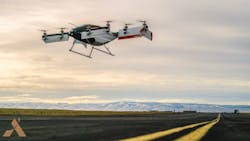Self-piloted aircraft and drones flying above Las Vegas
Airbus' Vahana aircraft successfully completes first full-scale flight test
Vahana, which is the all-electric, self-piloted, VTOL aircraft from A³ by Airbus, successfully completed its first full-scale flight test on Jan. 31.
During the test, which was completed at the Pendleton UAS Range in Pendleton, Oregon, Vahana reached a height of 16 feet, before descending safely. The fully self-piloted flight lasted for a total of 53 seconds.
"Today we are celebrating a great accomplishment in aerospace innovation," says Zach Lovering, Project Executive of Vahana.
"In just under two years, Vahana took a concept sketch on a napkin and built a full-scale, self-piloted aircraft that has successfully completed its first flight. Our team is grateful for the support we’ve received from A³ and the extended Airbus family, as well as our partners including MTSI and the Pendleton UAS Range."
Vahana is a project developed at A³, which is the Silicon Valley outpost of Airbus. According to A³, Vahana aims to "democratize personal flight and answer the growing need for urban mobility," by taking advantage of the latest technologies in electric propulsion, energy storage, and machine vision.
"Vahana’s first flight demonstrates Airbus’ unique ability to pursue ambitious ideas quickly, without compromising the quality and safety for which the company is well-known," says Rodin Lyasoff, A³ CEO and former Project Executive of Vahana.
"For A³, it proves that we can deliver meaningful innovation with aggressive project timetables, to provide a real competitive advantage for Airbus."
Vahana is operational without a passenger thanks to its self-piloted capabilities. Following these successful hover flights, the team will start focusing on additional testing, including transitions and forward flight.
Swift Aero granted permission to fly UAS in Class Bravo airspace in and around Las Vegas
Aerial service provider Swift Aero Aerial Systems (Swift Aero) has had its FAA Waiver Part 107.41 approved by the FAA, which will allow the company to fly UAS in key airport traffic areas and controlled airspace, known as Class Bravo airspace, in and around Las Vegas.
"We are absolutely thrilled to be the first aerial company to have this very special permission to fly UAS in Class Bravo Airspace in Las Vegas," says Craig McKay, President, Swift Aero Aerial Systems.
"This will open-up many opportunities for businesses already anchored here and those corporations who want to start-up here in Vegas."
Swift Aero has applied for other waivers still pending, including FAA Waiver 107.29, which allows UAS to be flown at night, FAA Waiver 107.39, which allows UAS to be flown over people, and FAA Waiver 107.31, which allows UAS to be flown beyond the pilot's visual line-of-sight (BVLOS).
Based in Las Vegas, Nevada, Swift Aero specializes in cinematography, broadcasting, mapping, photography and surveying services. With so many specialties, there is no shortage of potential clients that Swift Aero can work with now that it has obtained this permission, according to McKay.
"Attracting clients from a variety of industries including film and real estate, this permission is a major boon for Swift Aero as it expands its collaborations in 2018, offering more than just unmanned capabilities," McKay says.
View more information on the AUVSI.
Page 1 | Page 2

